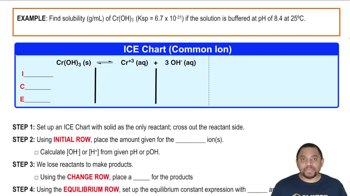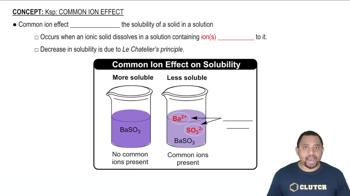Here are the essential concepts you must grasp in order to answer the question correctly.
Solubility Product Constant (Ksp)
The solubility product constant (Ksp) is an equilibrium constant that applies to the solubility of sparingly soluble ionic compounds. It is defined as the product of the molar concentrations of the ions, each raised to the power of their coefficients in the balanced equation. For magnesium hydroxide, Mg(OH)2, the Ksp expression is Ksp = [Mg^2+][OH^-]^2, which helps determine its solubility in different conditions.
Recommended video:
Solubility Product Constant
pH and its Effect on Solubility
pH is a measure of the acidity or basicity of a solution, which can significantly influence the solubility of certain compounds. In the case of magnesium hydroxide, a higher pH (more basic) increases the concentration of hydroxide ions (OH^-), which shifts the equilibrium and can lead to a decrease in solubility due to the common ion effect. Understanding how pH affects solubility is crucial for calculating solubility in buffered solutions.
Recommended video:
Solubility at Buffered pH Example
Common Ion Effect
The common ion effect refers to the decrease in solubility of an ionic compound when a solution already contains one of the ions present in the compound. For magnesium hydroxide, if the solution is buffered at pH 10, the increased concentration of hydroxide ions from the buffer will reduce the solubility of Mg(OH)2 compared to its solubility in pure water, where no common ions are present. This concept is essential for understanding solubility in buffered solutions.
Recommended video:
 Verified step by step guidance
Verified step by step guidance


